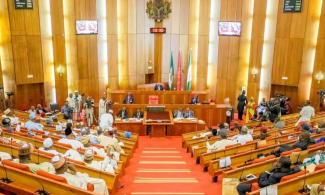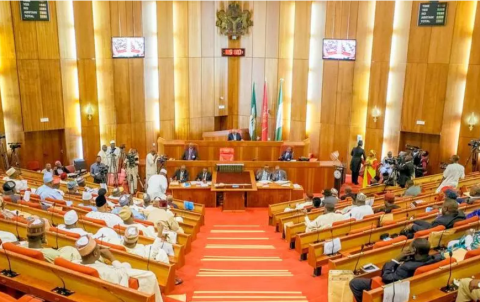
A lot has been said and is being said about the budget padding scandal that is currently unfolding, but it is important to situate this in its proper context, and to as well take a holistic and multi-dimensional approach to the analysis and understanding of the crisis.
Let me begin by acknowledging that I have borrowed in a modified manner the title of this piece from one of the seminal publications of the legendary Nigerian literary giant, the late Chinua Achebe titled ‘The Trouble With Nigeria’.
It is indicative of the monumental and historical nature of the crisis of leadership plaguing our country that decades after that publication, ‘the trouble with Nigeria’, rather than abated, has continued to fester and deepen.
The current scandal unfolding in the National Assembly, in its Green chamber – the 'House Of RepresentaThieves’ - around the accusations and counter-accusations of budget padding, is not only a continuation of the initial budget padding scandal that occasioned the preparation, passage and enactment of the 2016 Appropriation Act, but is also instructively one of the most manifest indications of the steep and historical decline in the quality of Nigeria’s ruling elites and class since flag independence in 1960.
A lot has been said and is being said about the budget padding scandal that is currently unfolding, but it is important to situate this in its proper context, and to as well take a holistic and multi-dimensional approach to the analysis and understanding of the crisis.
It is therefore important to situate the allegations of padding of the budget for constituency projects within the context of the padding of the entire 2016 Appropriation Act.
It is equally important to situate the padding of the 2016 budget within the context of the serial padding of all previous annual budgets since the 1999 return to civil rule.
What do I mean? Let me explain. The budgetary process in Nigeria since 1999, at all levels based on the so-called envelop system, has always been a work of ‘guesstimation' and at best based on pseudo-estimates.
A sum of money is arbitrarily allocated to various sectors and budget heads, and pseudo-planners then in turn arbitrarily sub-allocates these to different line items and sub-heads. The only empirical input into all of these is the estimation of revenue accruable to the federation each year, and the share of it going to the Federal government in accordance with the revenue allocation formula.
The annual budget projections, including the projections in the instruments of the Medium Term Expenditure Framework [MTEF] and the Medium Term Sectoral Strategies [MTSS] are not based on any scientific or systematic national development strategic planning framework; nor are they informed by any intelligent process of needs assessment and identification of priorities over the short [annual], medium [MTEF/MTSS] and long [5 year development plans] terms.
Without a national framework for strategic national development planning, a national development strategic and operational/implementation plan, or the entire structuring, organization, systems and processes of government oriented towards developing and implementing such plans, the annual budgeting process simply becomes an annual ritual of arbitrary allocations according to the respective whims and caprices of those responsible for preparing, enacting and implementing the budgets.
It is a process that allows for not only chaos, but also serial padding. It is why anyone knowledgeable about the budget process in Nigeria, anyone who has ever attempted to undertake the analysis, tracking and monitoring of the budget, anyone who has engaged with the budget process will be quick to point out their frustrations with the budget process.
Not only are the same line items repeated year in year out, but the same numbers of quantities continue to be purchased every year, but at sums marked up by the required 10 to 15% increase to take care of inflation etc!
This is why in 2012 a Senate investigation committee found out that since 1999 up to 2012 there were a total of approximately 8,000 abandoned federal [infrastructure] projects at a cost of nearly N12tn and for which more than N2.2tn paid in mobiliation fees had been lost.
Another Presidential Project Monitoring Team on NDDC projects also reported in 2013 that less than 30% of projects awarded by the NDDC were completed, the rest were either abandoned or were said to be ongoing, even though completion dates had been overshot and there were no indications that they would ever be completed.
Add to this pool the so-called constituency projects that have been budgeted for and for which allocations have been made since the inception of inclusion of constituency projects in the annual budgets in 2004.
Between the 2004 inception of the annual constituency projects budget and now is a period of 12 years. There are 469 members in the federal legislature, the NASS; if each federal legislator since 2004 have had constituency projects budgeted and allocated for, by now there should have been a total of 469 multiplied by 11 [that is a combined total of 5,159 federal constituency projects] federal constituency projects dotting the landscape of Nigeria, enough to go round the 774 LGAs approximately 7 times over.
The implication of this is that there ought to have been an average of 7 Federal constituency projects per LGA spread across the country by now, at a combined cost of N900bn in total budgetary allocations since 2004.
And mind you, this only just at the federal level. If we add State legislature constituency projects to the pool the figures would be nearer 10,000 such projects that ought to have been completed across Nigeria, the LGA average also rising to more than 10 projects per LGA, and the combined cost to public expenditure of nearly N1.5tn over 11 years.
The appropriate questions to ask include: where are the footprints of these constituency projects across the country? Where is the impact of this humongous N1.5tn of public investment on the infrastructural development and infrastructure deficit of the country?
Where did the monies go? How were constituency projects selected? What were the criteria for selection of projects? Siting of projects? What is the procedure for selection of contractors to implement the projects?
These constituency projects, into what national or State level development planning framework do they fit? What is the level of congruence between the selection of the projects and the priorities of the respective Federal and State governments? Is this constituency project contract award processes subjected to the provisions of the Public Procurement Act 2007, and the Public Procurement Manual 2011? Or are they in gross breach of this act? Can we therefore say that the National Assembly is consciously engaged in the process of willful breach of laws enacted by itself?
Before we go on, let us take a look at even the constitutionality of the constituency project phenomenon. As it is presently, the constituency projects regime has no legal framework nor were they envisaged or provided for in the present constitution.
This is why the process is largely arbitrary and subject to repeated and serial abuse. It is in fact, as it presently operates, a system of officially sanctioned corruption. The reason it has turned out this way cannot be isolated from its origin in the arm-twisting relationship between the executive and legislative arms of government and the consequent submission of the executive arm to legislative blackmail, in large part as a means for the executive to also protect itself from scrutiny by the legislator.
The constituency projects system arose in Nigeria as a result of an understanding by two arms of government to condone and officially sanction some degree of corruption in the fiscal regimes and processes of either arm.
This is why the current crisis provides an opportunity for active citizens to enter into the fray and to compel not only a holistic interrogation of the process and system since its inception, with a view to tracking how the resources have so far been utilized, identifying pilferers of our common teal, prosecuting offenders and recovering looted funds; but it should also provide an opportunity for a total and complete overhaul and reform of not only the constituency projects system, but also the entire budgetary and development planning processes, mechanisms, and structures across the federation.
We need to have a legislation to regulate the constituency project process and set out the principles on which the system will be managed, and the criteria for project selection, project siting, and project implementation.
We need to return to a national development planning framework that is informed by periodic needs assessment, periodic performance reviews of annual budgets, medium- and long-term development plan implementation processes and that in turn informs public investment priorities and profile in the short, medium and long terms.
As it is our current budgetary system and process is grossly defective, it is not informed by scientific and empirical analysis and information; it promotes guess work and in turn enables an environment for fraud and corruption.
In fact, it is safe to conclude that in this sense of the absence of strategic planning, all our budgets have been padded budgets in the broader sense. Otherwise how can we explain the scale of corruption and treasury looting? How can we explain the scale and scope of abandoned projects in the midst of a huge infrastructure deficit?
It is important at this point to state that the annual budget process in general, and the constituency projects budget component in particular, have also always been in breach of extant laws, in particular the Fiscal Responsibility Act.
This is because no annual budgetary process has involved, as provided for by the Fiscal Responsibility Act, a thorough review of the performance and fundamentals of the previous budget; nor have projections and estimates been rigorously interrogated against the backdrop of the MTEF and MTSS passed by the same legislative assemblies.
The point being made is that the current padding scandal rocking the NASS is not only a manifestation of the inherently and congenitally corrupt nature of our ruling political elites. It is much more significantly an indication of the defective and chaotic nature and character of our budgetary and planning processes in particular, and the arbitrary and anti-people nature of governance in our country in general.
That is why operatives of the executive arm of government and members of the legislative arm of government could have without coordination undertaken the padding of the budget in parallel processes!
Before we conclude, let us pose another question. Is it conceivable that the House Of RepresentaThieves could have successfully singlehandedly padded only the constituency projects for the House to the exclusion of the ‘Sinate’? And could they have been responsible singlehandedly for padding the entire budget to the exclusion of the ‘Sinate’?
This present regime is as complicit as the previous ones in the mess that is unfolding. It had promised a zero budgeting process, but has instead delivered a padded modified envelop budgeting system.
A zero budget requires planning; it is based on a needs assessment and priority selection process that is of necessity to a multi-stakeholder process in nature, and that makes widespread and structured multi-stakeholder consultation and participatory process mandatory.
What is currently happening and unfolding is a wakeup call to all active citizens to Take Our Destinies Back into our Hands; To Reclaim our Humanity from these hordes of locusts; and to Take Back Our Country from the thieving light-fingered ruling elite.
Jaye Gaskia is the National Coordinator of the Protest to Power Movement and Co-Convener of the Say No Campaign. He can be followed on Twitter @jayegaskia and on Facebook at Jaye Gaskia and Take Back Nigeria.
